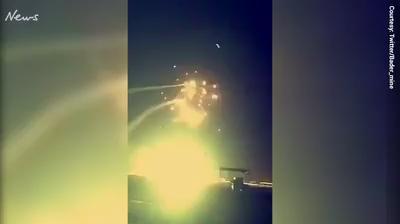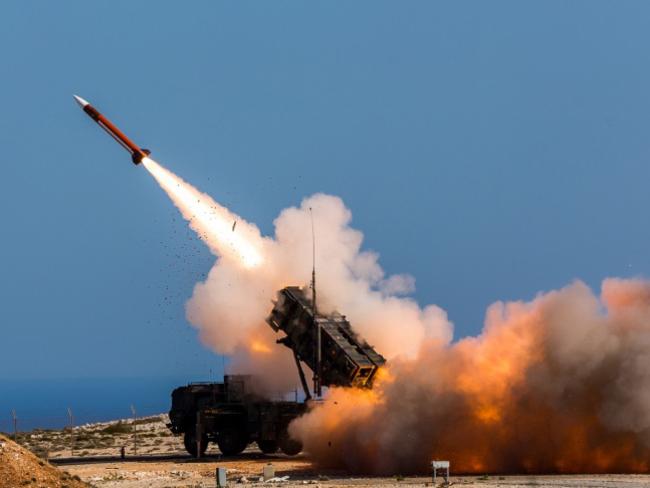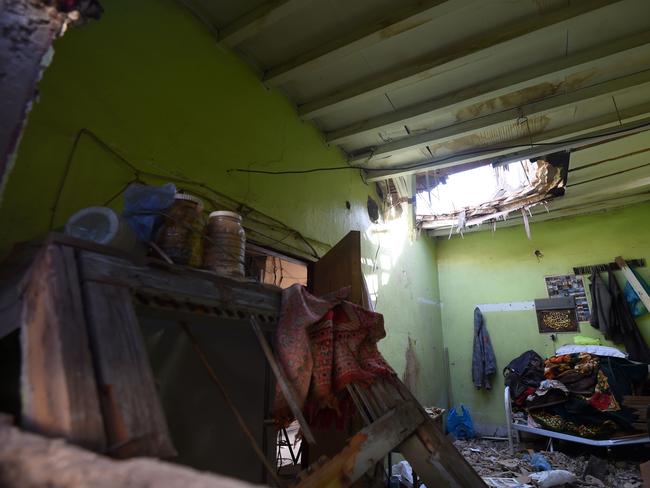US Patriot ballistic missile defence system may have ‘failed’ over Saudi Arabia
THE footage was dramatic: missiles streaming upwards to defend Saudi Arabia’s capital, Riyadh. But it may have exposed a startling failure of the US-built ballistic shield.

SEVEN ballistic missiles were lobbed at Saudi Arabia on Monday.
They were launched from Yemen by the Iran-backed Houthi rebel group.
According to Saudi Press authorities, all were shot down.
But some defence analysts aren't’ so certain.
#BREAKING: Footage sent to Al Arabiya shows moment anti-defense missiles from #Saudi Patriot batteries fired to intercept apparent #Houthi missile over #Riyadh.
— Al Arabiya English (@AlArabiya_Eng) March 25, 2018
Follow updates here: https://t.co/s4TdYoXf6e pic.twitter.com/0GkBiOvZl3
A torrent of videos and photos streamed out of the capital, Riyadh, immediately after the attack. They showed one US-built Patriot anti-ballistic missile system pumping guided projectiles into the sky.
But analysts point out, that same footage appears to show at least two of the five missiles misfired.
Haven’t analyzed all the videos yet, but it looks like one interceptor failed catastrophically (left) and another pulled a u-turn and exploded in Riyadh (right). Not a good day for Saudi missile defenses. pic.twitter.com/4xtgTQwGSM
— Jeffrey Lewis (@ArmsControlWonk) March 26, 2018
هذا المقطع وصلنا للتو #سقوط_صاروخ_على_الرياض pic.twitter.com/19YtGVnImP
— بدر بن طلال الرشيد (@bintalal82) March 25, 2018
One blows up in a spectacular cloud of glowing debris immediately after it launched.
Another is seen, from several different angles, suddenly veering off course and into the ground — erupting in a shower of fragments.
And while others are seen bursting — as intended — high in the sky near incoming warheads, analysts are questioning whether or not any of them actually hit their targets.
Interesting note on the Qiam missile (AKA Burkan 2) displayed by Saudi military: Those missiles separated the RV successfully and probably landed on soft sand - hence almost no damage. Clearly this pair was not intercepted. pic.twitter.com/OgY4xnFOUl
— Tal Inbar (@inbarspace) March 27, 2018
Photos of remnants of a ballistic missile that reportedly landed in Riyadh house where Egyptian was killed. No sign of fragmentation damage from Patriot PAC-2/GEM-T missile pic.twitter.com/Nof6i9m9VG
— Jeremy Binnie (@JeremyBinnie) March 26, 2018
Photos of the remains of the Houthi missiles have been circulating on Facebook and Twitter. None appear to show any signs of the telltale splinter holes designed to shred them into harmless pieces.
This is a problem for the United States.

HIT-AND-MISS
The Pentagon is relying heavily upon fast, accurately guided systems such as the Patriot to defend its ground facilities from large scale enemy attacks — and even potential nuclear warheads launched from the likes of North Korea.
And the Patriot already has a chequered history.
It was commissioned as an area-defence system in 1984. It went to war for the first time in 1991, defending cities and bases from Suddam Hussein’s Scud missile attacks.
Houthi conduct series of missile attacks at King Khalid airport in Riyadh, airport in Asir and targets in Jizan. Today the 3rd anniversary of Saudi invasion in Yemen. pic.twitter.com/lOmdrOI1r3
— Yemen Observer (@YemeniObserv) March 25, 2018
In 2003, the system shot down two aircraft during the US-led invasion of Iraq. The problem was, they were allies — not enemies.
“It’s nothing but an unbroken trail of disasters with this weapon system,” MIT physicist Theodore Postol told Motherjones. “In the Gulf War of 1991, we definitely saw Patriots take off, turn around and dive to ground in both Saudi Arabia and in Israel.”
This is bad news for a United States that has just dramatically expanded its anti-ballistic missile defence program.
BREAKING: Saudi air defense intercepts ballistic missile over Riyadh; loud explosions heard across the capital pic.twitter.com/gprUbjEN8C
— Josh Caplan (@joshdcaplan) March 25, 2018
It’s been battling with a series of test failures in its next-generation ballistic missile defences. Many simply miss their target. Others suffer failures in their complex guidance and control systems.
When doing the equivalent of shooting a bullet with a bullet, everything must operate perfectly for success.

SAUDI ANGER
Saudi forces insist they intercepted the seven missiles launched at them on Sunday night their time, including over the capital Riyadh.
They call it a deadly escalation that coincided with the third anniversary of the coalition’s intervention in Yemen.
Displaying wreckage at a news conference in Riyadh of what it said were fragments of those ballistic missiles, the coalition claimed forensic analysis showed they were supplied to Huthi rebels by their ally Iran.
“The missiles launched against Saudi territory were smuggled from Iran,” coalition spokesman Turki al-Malki told reporters.

We “reserve the right to respond against Iran at the right time and right place”, he added.
The missile strikes resulted in the first reported fatality from Huthi fire in the Saudi capital.
Egyptian national Abdul-Moteleb Ahmed, 38, died instantly in his bed when what appeared to be burning shrapnel struck his ramshackle room in Riyadh’s Um al-Hammam district, leaving a gaping hole in the roof, witnesses told by AFP at the site.
Three other Egyptian labourers in the same room were wounded and hospitalised, they said.
The Iran-aligned Huthis said on their Al-Masirah television that Riyadh’s King Khalid International Airport was among the targets.
Malki alleged the rebels in Sanaa were using the airport there to launch missiles on Saudi territory, adding the coalition had seized a number of smuggled weapons.

IRAN DENIES LINK
Iran has repeatedly denied arming the Huthis in Yemen, despite claims by the United States and Saudi Arabia that the evidence of an arms connection is irrefutable.
“These warmongering and irresponsible remarks can be followed up legally at the international level,” said foreign ministry spokesman Bahram Ghasemi in a statement.
“The aim of such claims by Saudi Arabia is to divert public opinion from the atrocities (they) are committing in Yemen,” added Yadollah Javani, a political officer for Iran’s elite Revolutionary Guards, according to the conservative Tasnim news agency.
“The reality is that the nation of Yemen is standing up to Saudi aggression and has managed to build defence tools by relying on its own capabilities, including missile power, and this is the very thing Saudi Arabia never imagined,” he added.
Javani said it was impossible to send weapons to Yemen due to the blockade imposed by the Saudi-led coalition, which has been engaged in an aerial bombing campaign against the Huthis since 2015.



